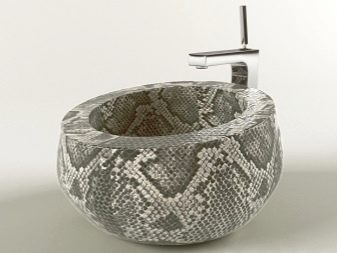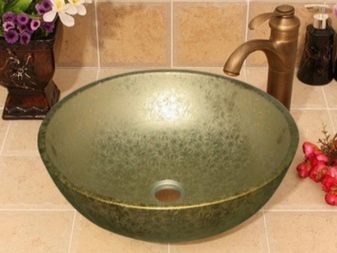Overhead Bathroom Sinks
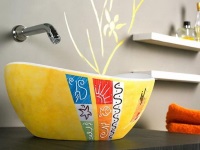
The design of the bathroom affects a person's emotional mood in many ways. Here the sink is one of the most important decorative elements.
The market offers many models of washbasins and it is not easy to make a choice. Of course, you have to start with the technical characteristics of the devices. What criterion will be decisive for you in this case? First of all it should be their reliability and durability. Of course, the functionality of the product is also important, as well as its design, the importance of which everyone determines for himself. It is precisely such indicators correspond to the overhead sinks, which will be discussed below.
These sinks can be any shape, but they are installed only on top of any flat horizontal surface, like a basin on the table. Let's take a look at what makes them so remarkable.
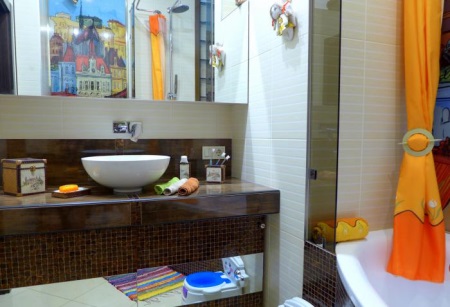
Pros
Overhead sinks have a lot of advantages over other types of sinks.
Namely, they:
- significantly save space, as they do not take up much space, unlike a conventional sink;
- They are universal in terms of installation, that is, they can be installed anywhere in the bathroom;
- They are easy to connect to the water supply and sewerage system.
- They can be easily placed on a convenient plane, whether it is a tabletop, a cabinet, a cabinet or even the washing machine;
- If the surface on which you are going to place the hand basin will be larger, it will serve as additional space for handy things, which is very convenient.
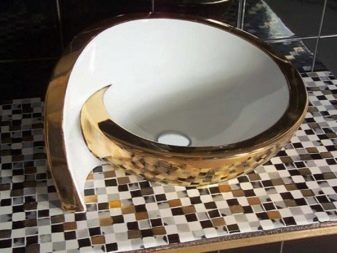
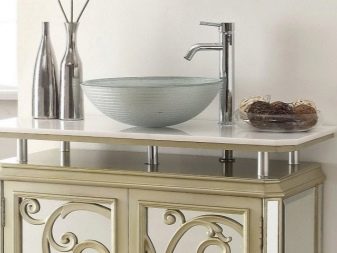
Cons
Having identified the advantages of overhead sinks it is necessary to note the disadvantages, which, judging from the technical side, to be honest, there are none. But note that most of these sinks do not have a hole for the mixer, and this is a big disadvantage. Therefore, before buying, think through where you will install the faucet - on the wall, the countertop or anywhere else.
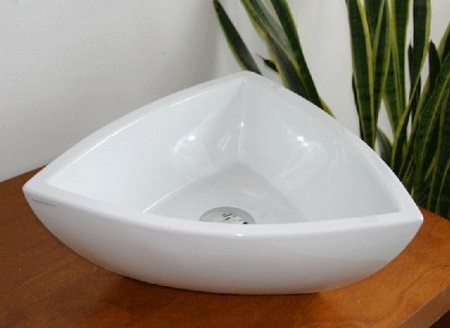
Materials
Today, many people strive to bring something rare, unusual, new into their lives. Sanitary appliances made of the usual faience, majolica, porcelain are now increasingly competing with products made of natural stone, glass, wood and metal. These non-traditional materials are also used to make overhead sinks. Let's consider each of them in more detail.
Wood
It would seem that this is the most unsuitable material for the production of this equipment. But this is only at first glance. Thanks to modern technology the union of wood and water has become harmonious and durable. This is due to the qualitative treatment of wood with special rot-resistant preparations and water-repellent varnish. Companies guarantee unlimited life time, and besides, such sinks look very stylish.
There are models made from special types of wood, which by nature are highly resistant to rot, hardness and water resistance. But keep in mind that the price here will be significantly higher.
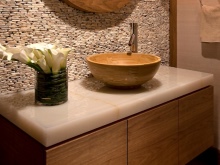
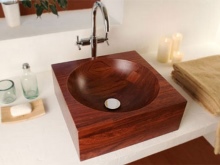
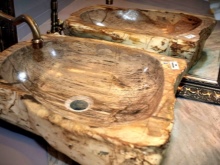
Glass
What only washbasins today do not meet from this fragile-looking material. The variety of shapes and colors is simply amazing. Although glass appears to be fragile, it really isn't. Many of its characteristics are constantly being improved, some types are even scratch-resistant. Some of the glass sanitary ware on the market is made of triplex, while others are made of tempered glass. Resistance of the latter to mechanical stress and sharp temperature changes is very high, take it into account when buying.
The main disadvantage of such models is the need for constant care. Because of contact with water on the surface remain stains and drips, so it is better to choose matte glass or with a pattern. Although manufacturers have taken care of this - some products have a special coating, thanks to which water droplets are instantly rolled away, taking with them dirt and lime impurities.
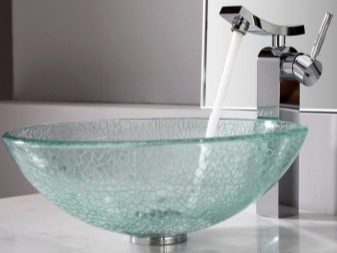
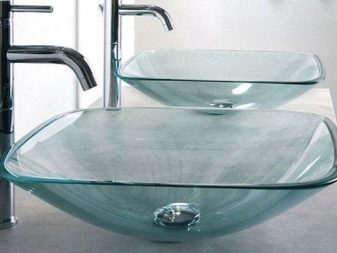
Stone
An overhead sink can be made of both natural stone and artificial stone. The latter fully imitates natural materials and allows you to create products of any configuration and color. Ceramic granite and acrylic are most commonly used here, but agglomerated composite materials are also becoming more and more common. Each species has excellent durability properties.
For the production of natural sinks are mainly used marble, granite and onyx. These materials have a rich texture, excellent durability, but at the same time are difficult to care for, have a large weight and a significant cost.
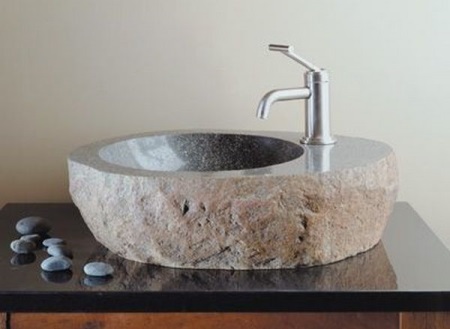
Metal
Do not think that a metal washbasin - this is a simple and cheap option for the bathroom. In the hands of craftsmen and ordinary stainless steel can turn into a stunning art object. Brass, steel, nickel, copper or bronze are also used for production. They can be matte, semi-matte or shiny, but in any case, each of them looks respectable, elegant and refined in its own way.
The disadvantage of such washbasins is that they hum when filled with water. To avoid this, they are covered with rubber on the inside. Also, to maintain cleanliness, products with a mirror surface require careful care to avoid scratches.
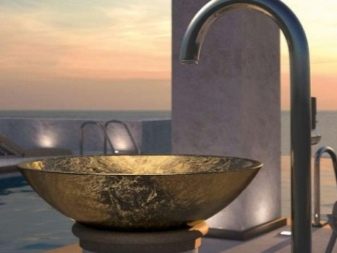
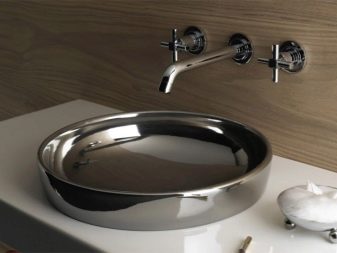
Sanitary ceramics
Here is used familiar to all faience, or porcelain. Standard white sanitary ware has long proven itself with its durability and ease of use, but it has lost its individuality, receiving not the most modern image. However, it is still in demand, thanks to its practicality and affordable price.

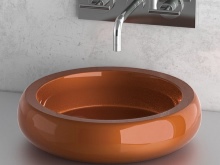
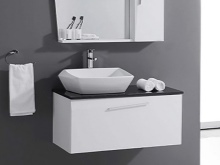
Shapes
No other piece of sanitary ware is distinguished by such a variety of forms as the washbasins. Most of them are presented in the form of a circle, oval, square or rectangle. Sinks with this modification will fit any interior, which is why they are in demand in the market.
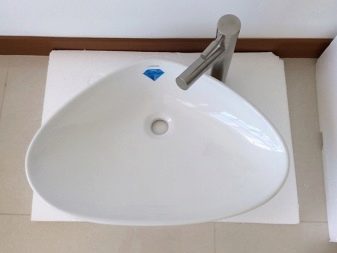
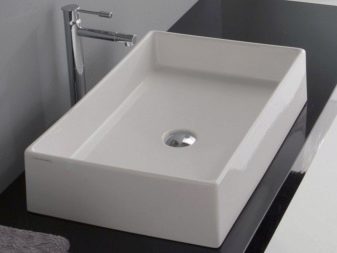
Of course, the configuration of overhead sinks is not limited to simple geometric shapes. Manufacturers are now increasingly happy with their original ideas. But it is worth considering that, for example, a hand basin in the form of a flower, will require a special environment in the bathroom.
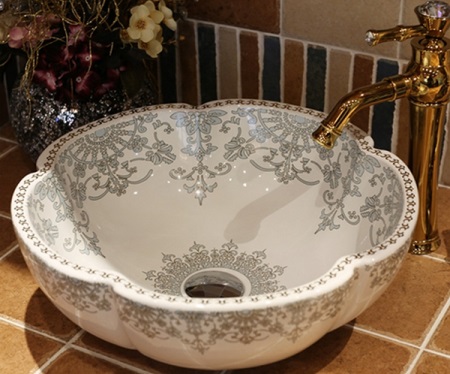
Dimensions
When choosing washbasins, you need, first of all, to proceed from the size of the room itself. If there is a lot of free space, then large sinks and freestanding furniture, of course, will be preferred. Such devices are mainly made to order, according to the presented measures of the client. However, there is a standard size of overhead sinks:
- Small - width 40-55 cm, depth 12-35 cm;
- Medium - width 55-75 cm, depth 35-48 cm;
- Large - width 75-120 cm, depth 48-61 cm.
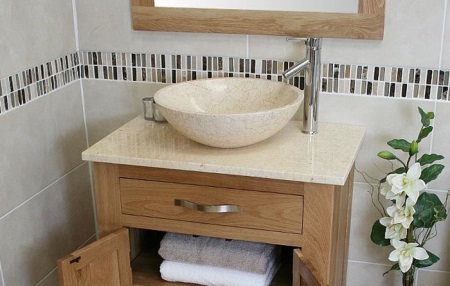
Choosing tips
In order for the new overhead washbasin to justify itself in the future, we advise to adhere to simple recommendations before buying:
- First of all, thoroughly check the devices. They should not have any defects such as cracks and chips, this is the first sign of durability;
- To avoid traumatic situations, especially if there are children in the family, the shape of the sink is desirable without sharp corners;
- Determining the configuration of the product, make sure that the dimensions do not exceed the dimensions you allow;
- The faucet must match the height of the overhead sink. The deeper the device, the higher the faucet should be installed.
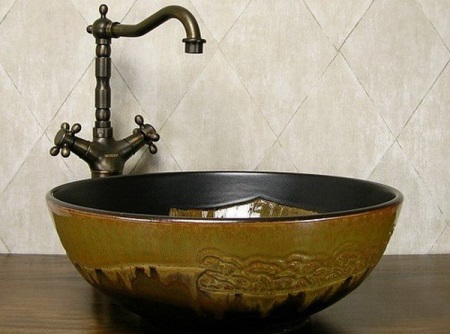
Installation
Installation of this type of sink is relatively simple and almost no different from the installation of other sinks. The main thing here is to properly hide the supply and drain system.
When installing, observe the following steps:
- For the washbasin on the surface to be installed, make a small hole according to the diameter of the neck of the siphon spigot;
- Then, the drainage hole of the bowl is aligned with the passage made in the countertop and glued with silicone, which gives a tight structure;
- Now put the siphon itself and be sure to check the tightness of joints;
- Next, the sink is installed on the faucet and the accompanying supply to it;
- If the washbasin has no place under the faucet, then the faucet is located on the countertop or wall. The latter option will require additional equipment to install the faucet by the hidden type, hiding all communications.
Connecting to the sewer
Overhead sink, as well as any other is necessarily connected to the sewage system. This is a standard procedure, where a siphon is installed on the washbasin to drain water, and the siphon pipe is led out and inserted into the sewage hole. If suddenly the diameters of the pipes do not match, adapter sleeves are used. Once the connection is made, all connections are checked for proper operation.
Prices
We present you an overview of the prices of overhead sinks from different manufacturers.
| Country |
Porcelain, faience, majolica (in rubles) |
Stone (in rubles) |
Tree (in rubles) |
Metal (in rubles) |
Glass (in rubles) |
| Germany | from 4000 | from 10000 | from 60000 | from 30000 | |
| India | from 4000 | from 15000 | from 40000 | ||
| Spain | from 3000 | ||||
| Italy | from 5000 | from 25000 | from 75000 | from 30000 | from 20000 |
| China | from 1500 | from 2,000 | |||
| Russia | from 1700 | ||||
| USA | from 4,000 | from 60000 | from 60000 | from 13000 | |
| Switzerland | from 3000 | from 19000 |
The popularity of overhead sinks is only increasing every year. This is due to their functionality and technical characteristics. In addition, these sinks are compact and easy to use.
